
identification of fiber
- 1. Hamza sameen Assignment of Textile Method of identification of fiber:- Through burn test. Through Microscopic Analysis. Behaviors in Solution. Identification of cotton fiber by burn:- Burns, but does not melt. It has the odor of burning paper leaves, or wood. The residue is a fine, feathery, gray ash.
- 2. Microscopic analysis:- The cotton fiber is a single elongated cell. Under a microscope, it looks like flat, spirally twisted ribbon like tube with rough granular surface. However, mercerized cotton doesn't have natural twist. The finishing process makes them swollen, straight, smooth and round with a shining surface. The thin cell wall of the fiber has from 200 to 400 convolutions per inch.
- 3. Chemical test:- As strong alkali destroy animal substances, a 5%of soda lye solution in water can be used to eliminate wool and silk fibers from a sample that contains a mixture of fiber. The vegetable fibers will not be affected by this solution. WOOL FIBER:-
- 4. Burn testing:- It is also a protein fiber but is harder to ignite than silk as the individual "hair" fibers are shorter than silk and the weave of the fabrics is generally looser than with silk. The flame is steady but more difficult to keep burning. The smell of burning wool is like burning hair. C
- 5. Wool Fiber has irregular, roughly cylindrical, multi cellular structure with tapered ends. Under a microscope, three basic layers are shown- epidermis (outer layer), cortex (middle layer) and medulla (inner layer). Medulla is seen only in coarse and medium wool fibers and that too under a highly powerful microscope. Chemical Test:- The use of concentrated cold hydrochloric acid will dissolve the silk and the wool fiber swells.
- 6. LINEN:- Burn Test:- Linen takes longer to ignite. The fabric closest to the ash is very brittle. Linen is easily extinguished by blowing on it as you would a candle. Microscopic analysis: Under the microscope, the hair like flax fiber shows several sided cylindrical filaments with fine pointed ends. The fiber somewhat resembles a straight, smooth.
- 7. Chemical Test:- Cotton and linen are immersed in a 1% solution of fuchsine in alcohol to give red rose color. Later, they are washed and immersed into ammonia, linen retains the red coloration but cotton does not. SILK:- Burning Test:- It is a protein fiber and usually burns readily, not necessarily with a steady flame, and smells like burning hair. The ash is easily crumbled. Silk samples are not as easily extinguished as cotton or linen.
- 8. Microscopic analysis: It appears somewhat elliptical and triangular in cross section. When we see under the microscope it is composed of fibroin, consisting of two filaments, called brim which is held together by service.
- 9. Chemical Test:- The use of concentrated cold hydrochloric acid will dissolve the silk and the wool fiber swells. Man Made Fibers:- Acetate: Burning test: Acetate burns readily with a flickering flame that cannot be easily extinguished. The burning cellulose drips and leaves a hard ash. The smell is similar to burning wood chips. Microscopic analysis: The cross sectional view has a bulbous or multi global appearance with indentations.
- 10. These indentations appear as occasional markings. Rayon:- Burning test: It is a regenerated cellulose fiber which is almost pure cellulose. Rayon burns rapidly and leaves only a slight ash. The burning smell is close to burning leaves .
- 11. Microscopic analysis: Rayon fibers have a glasslike luster under the microscope and appear to have a uniform diameter when viewed longitudinally
- 12. POLYESTERS: Burning test: Polyester melts and burns at the same time, the melting, burning ash can bond quickly to any surface it drips on including skin. The smoke from polyester is black with a sweetish smell. The extinguished ash is hard.
- 13. Microscopic analysis:- Generally, polyester fibers are smooth and straight and the cross-section is round. These general characteristics may be altered to achieve certain characteristics. CHEMICAL TEST:- Polyester is soluble in hot Meta cresol; however, unlike acetate it is not soluble in acetone, and unlike nylon. it is not soluble in concentrated formic acid.